这篇文章主要介绍了rabbitmq五种模式的示例分析,具有一定借鉴价值,感兴趣的朋友可以参考下,希望大家阅读完这篇文章之后大有收获,下面让小编带着大家一起了解一下。
一、五种模式详解
1.简单模式(Queue模式)
当生产端发送消息到交换机,交换机根据消息属性发送到队列,消费者监听绑定队列实现消息的接收和消费逻辑编写.简单模式下,强调的一个队列queue只被一个消费者监听消费.
1 结构

生产者:生成消息,发送到交换机交换机:根据消息属性,将消息发送给队列消费者:监听这个队列,发现消息后,获取消息执行消费逻辑
2应用场景
常见的应用场景就是一发,一接的结构
例如:
手机短信邮件单发
2.争抢模式(Work模式)
强调的也是后端队列与消费者绑定的结构
1结构

生产者:发送消息到交换机交换机:根据消息属性将消息发送给队列消费者:多个消费者,同时绑定监听一个队列,之间形成了争抢消息的效果
2应用场景
抢红包
资源分配系统
3.路由模式(Route模式 Direct定向)
从路由模式开始,关心的就是消息如何到达的队列,路由模式需要使用的交换机类型就是路由交换机(direct)
1 结构

生产端:发送消息,在消息中处理消息内容,携带一个routingkey
交换机:接收消息,根据消息的routingkey去计算匹配后端队列的routingkey
队列:存储交换机发送的消息
消费端:简单模式 工作争抢
2应用场景
短信
聊天工具
邮箱。。
手机号/邮箱地址,都可以是路由key
4.发布订阅模式(Pulish/Subscribe模式 Fanout广播)
不计算路由的一种特殊交换机
1结构
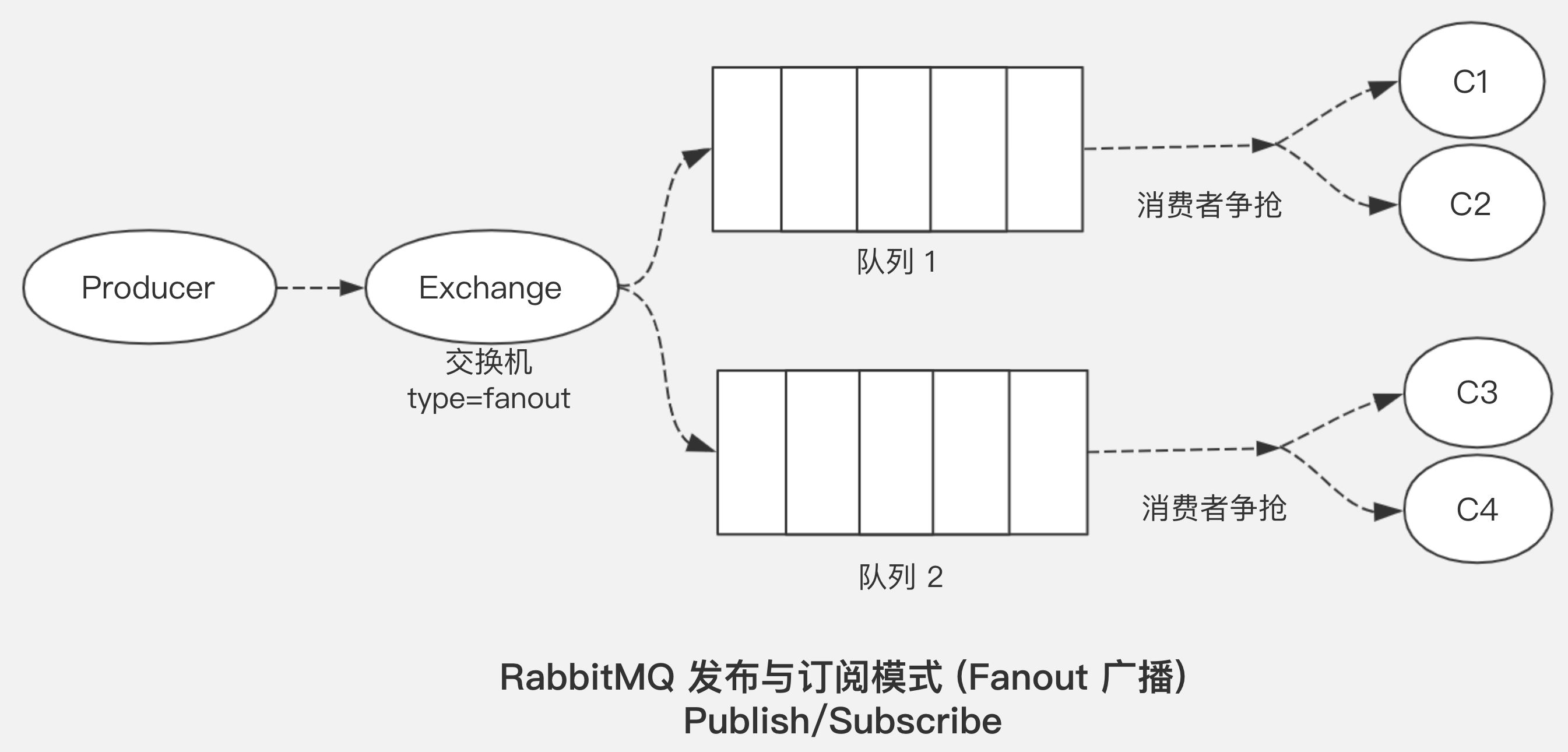
2应用场景
消息推送
广告
5.主题模式(Topics模式 Tpoic通配符)
路由key值是一种多级路径。中国.四川.成都.武侯区
1结构

生产端:携带路由key,发送消息到交换机
队列:绑定交换机和路由不一样,不是一个具体的路由key,而可以使用*和#代替一个范围
| * | 字符串,只能表示一级 |
| --- | --- |
| # | 多级字符串 |
交换机:根据匹配规则,将路由key对应发送到队列
消息路由key:
北京市.朝阳区.酒仙桥
北京市.#: 匹配true
上海市.浦东区.*: 没匹配false
新疆.乌鲁木齐.#
2 应用场景
做物流分拣的多级传递.
6.完整结构
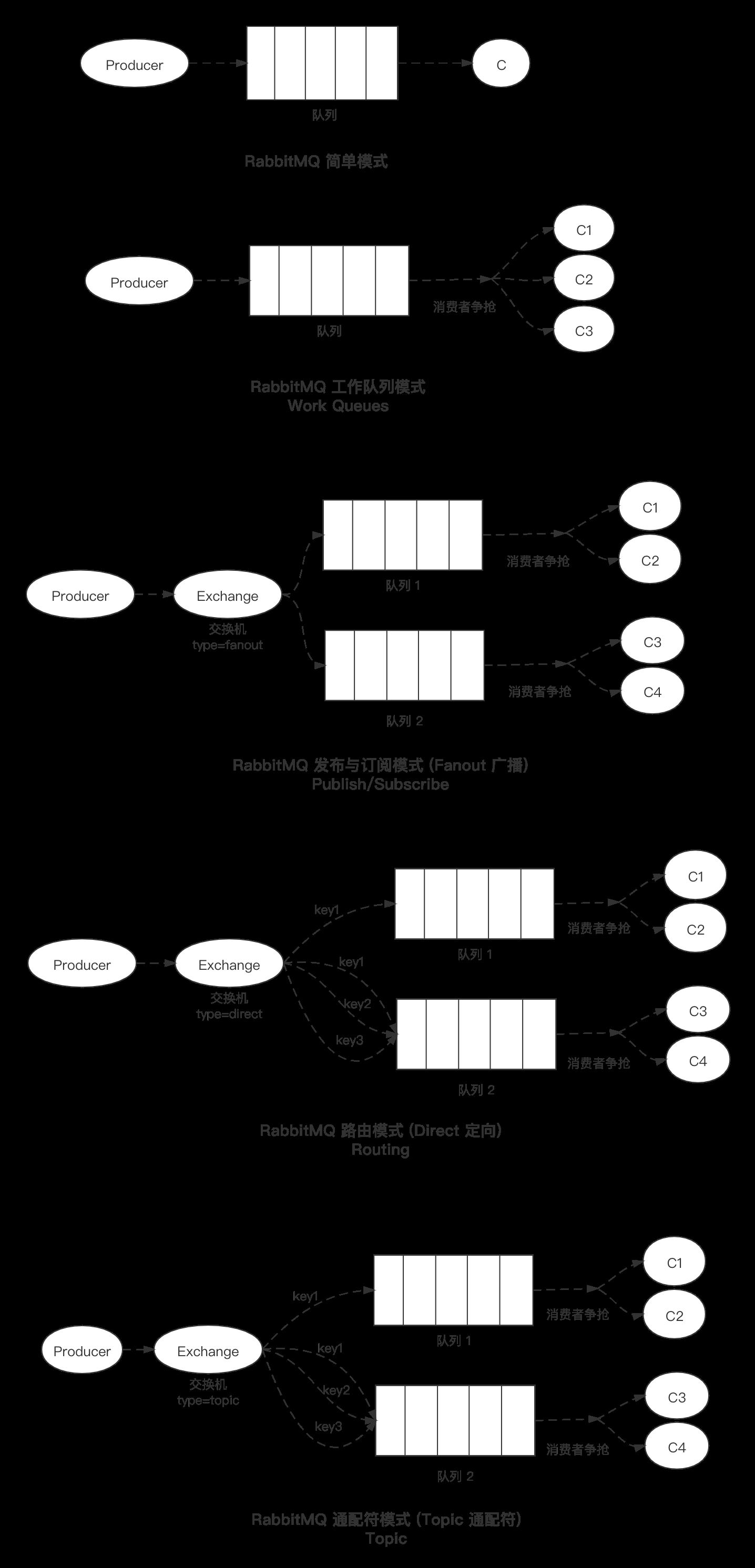
二、代码实现
1.创建SpringBoot工程
1 工程基本信息

2 依赖信息

3 配置文件applicasion.properties
# 应用名称spring.application.name=springboot-demo# Actuator Web 访问端口management.server.port=8801management.endpoints.jmx.exposure.include=*management.endpoints.web.exposure.include=*management.endpoint.health.show-details=always# 应用服务 WEB 访问端口server.port=8801######################### RabbitMQ配置 ######################### RabbitMQ主机spring.rabbitmq.host=127.0.0.1# RabbitMQ虚拟主机spring.rabbitmq.virtual-host=demo# RabbitMQ服务端口spring.rabbitmq.port=5672# RabbitMQ服务用户名spring.rabbitmq.username=admin# RabbitMQ服务密码spring.rabbitmq.password=admin# RabbitMQ服务发布确认属性配置## NONE值是禁用发布确认模式,是默认值## CORRELATED值是发布消息成功到交换器后会触发回调方法## SIMPLE值经测试有两种效果,其一效果和CORRELATED值一样会触发回调方法,其二在发布消息成功后使用rabbitTemplate调用waitForConfirms或waitForConfirmsOrDie方法等待broker节点返回发送结果,根据返回结果来判定下一步的逻辑,要注意的点是waitForConfirmsOrDie方法如果返回false则会关闭channel,则接下来无法发送消息到broker;spring.rabbitmq.publisher-confirm-type=simple# RabbitMQ服务开启消息发送确认spring.rabbitmq.publisher-returns=true######################### simple模式配置 ######################### RabbitMQ服务 消息接收确认模式## NONE:不确认## AUTO:自动确认## MANUAL:手动确认spring.rabbitmq.listener.simple.acknowledge-mode=manual# 指定最小的消费者数量spring.rabbitmq.listener.simple.concurrency=1# 指定最大的消费者数量spring.rabbitmq.listener.simple.max-concurrency=1# 开启支持重试spring.rabbitmq.listener.simple.retry.enabled=true2.简单模式
1 创建SimpleQueueConfig 简单队列配置类
package com.gmtgo.demo.simple;import org.springframework.amqp.core.Queue;import org.springframework.context.annotation.Bean;import org.springframework.context.annotation.Configuration;@Configurationpublic class SimpleQueueConfig { private final String simpleQueue = "queue_simple"; @Bean public Queue simpleQueue() { return new Queue(simpleQueue); }}2 编写生产者
package com.gmtgo.demo.simple;import lombok.extern.slf4j.Slf4j;import org.springframework.amqp.rabbit.core.RabbitTemplate;import org.springframework.beans.factory.annotation.Autowired;import org.springframework.stereotype.Component;@Slf4j@Componentpublic class SimpleProducer { @Autowired private RabbitTemplate rabbitTemplate; public void sendMessage() { for (int i = 0; i < 5; i++) { String message = "简单消息" + i; log.info("我是生产信息:{}", message); rabbitTemplate.convertAndSend( "queue_simple", message); } }}3 编写消费者
package com.gmtgo.demo.simple;import com.rabbitmq.client.Channel;import lombok.extern.slf4j.Slf4j;import org.springframework.amqp.core.Message;import org.springframework.amqp.rabbit.annotation.RabbitListener;import org.springframework.stereotype.Component;import java.io.IOException;@Slf4j@Componentpublic class SimpleConsumers { @RabbitListener(queues = "queue_simple") public void readMessage(Message message, Channel channel) throws IOException { channel.basicAck(message.getMessageProperties().getDeliveryTag(), false); log.info("我是消费信息:{}", new String(message.getBody())); }}4 编写访问类
package com.gmtgo.demo.simple;import org.springframework.beans.factory.annotation.Autowired;import org.springframework.web.bind.annotation.RequestMapping;import org.springframework.web.bind.annotation.RestController;@RestController@RequestMapping(value = "/rabbitMq")public class SimpleRabbitMqController { @Autowired private SimpleProducer simpleProducer; @RequestMapping(value = "/simpleQueueTest") public String simpleQueueTest() { simpleProducer.sendMessage(); return "success"; }}5 测试启动项目访问 simpleQueueTest
访问地址:http://127.0.0.1:8801/rabbitMq/simpleQueueTest
结果:

3.Work队列
1 编写工作配置
package com.gmtgo.demo.work;import org.springframework.amqp.core.Queue;import org.springframework.context.annotation.Bean;import org.springframework.context.annotation.Configuration;@Configurationpublic class WorkQueueConfig { private final String work = "work_queue"; @Bean public Queue workQueue() { return new Queue(work); }}2 编写生产者
package com.gmtgo.demo.work;import lombok.extern.slf4j.Slf4j;import org.springframework.amqp.rabbit.core.RabbitTemplate;import org.springframework.beans.factory.annotation.Autowired;import org.springframework.stereotype.Component;@Slf4j@Componentpublic class WorkProducer { @Autowired private RabbitTemplate rabbitTemplate; public void sendMessage() { for (int i = 0; i < 10; i++) { String message = "工作消息" + i; log.info("我是生产信息:{}", message); rabbitTemplate.convertAndSend("work_queue", message); } }}3 编写消费者1
package com.gmtgo.demo.work;import com.rabbitmq.client.Channel;import lombok.extern.slf4j.Slf4j;import org.springframework.amqp.core.Message;import org.springframework.amqp.rabbit.annotation.RabbitListener;import org.springframework.stereotype.Component;import java.io.IOException;@Slf4j@Componentpublic class WorkConsumers1 { @RabbitListener(queues = "work_queue") public void readMessage(Message message, Channel channel) throws IOException { channel.basicAck(message.getMessageProperties().getDeliveryTag(), false); log.info("我是消费信息1:{}", new String(message.getBody())); }}4 编写消费者2
package com.gmtgo.demo.work;import com.rabbitmq.client.Channel;import lombok.extern.slf4j.Slf4j;import org.springframework.amqp.core.Message;import org.springframework.amqp.rabbit.annotation.RabbitListener;import org.springframework.stereotype.Component;import java.io.IOException;@Slf4j@Componentpublic class WorkConsumers2 { @RabbitListener(queues = "work_queue") public void readMessage(Message message, Channel channel) throws IOException { channel.basicAck(message.getMessageProperties().getDeliveryTag(), false); log.info("我是消费信息2:{}", new String(message.getBody())); }}5 编写测试方法
package com.gmtgo.demo.work;import org.springframework.beans.factory.annotation.Autowired;import org.springframework.web.bind.annotation.RequestMapping;import org.springframework.web.bind.annotation.RestController;@RestController@RequestMapping(value = "rabbitMq")public class WorkRabbitMqController { @Autowired private WorkProducer workProducer; @RequestMapping(value = "workQueueTest") public String workQueueTest() { workProducer.sendMessage(); return "success"; }}6 测试启动项目访问 workQueueTest
访问地址http://127.0.0.1:8801/rabbitMq/workQueueTest
结果:
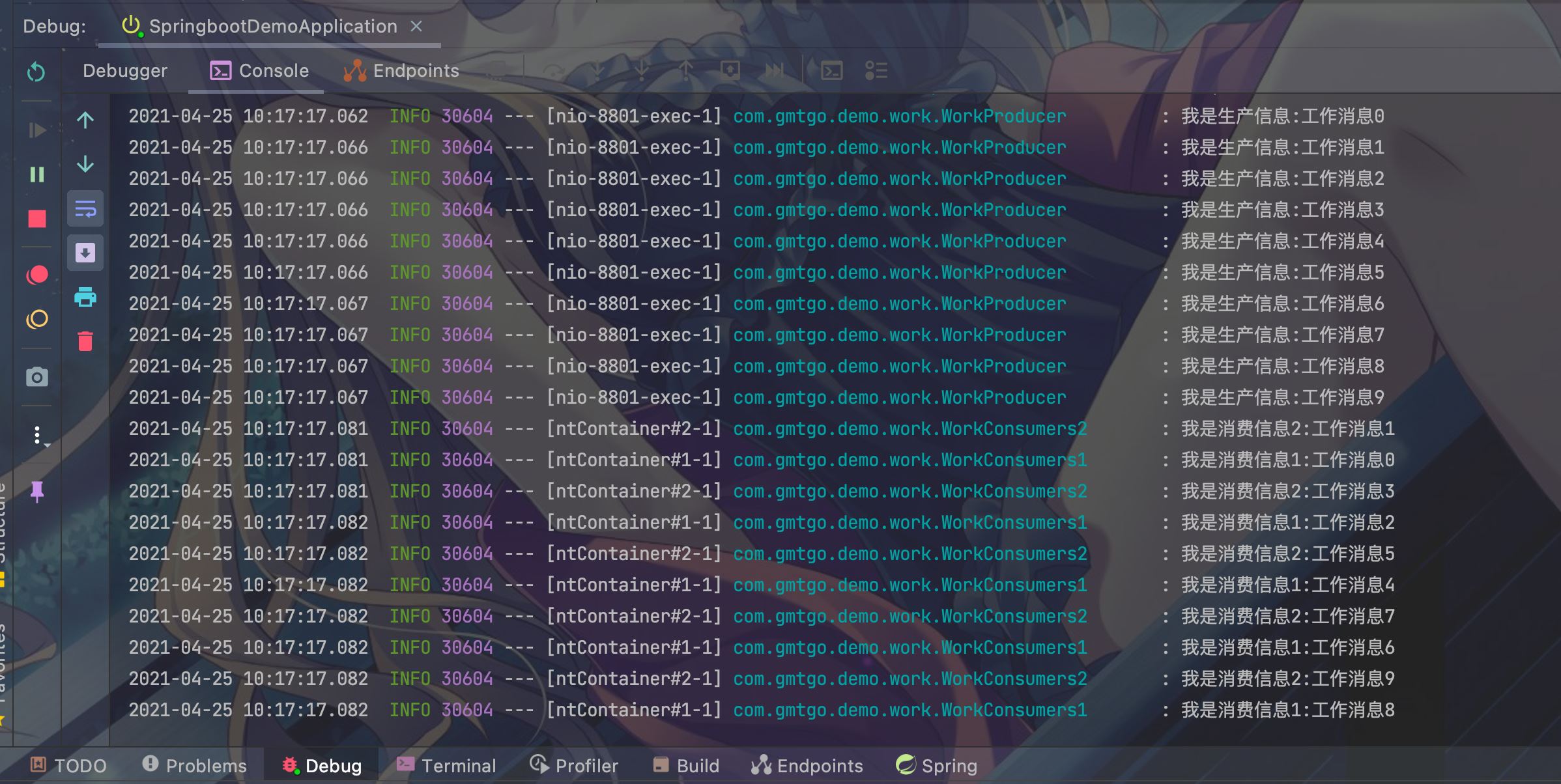
控制台打印,发现10条消息 偶数条消费者1获取,奇数条消费者2获取,并且平均分配。
当然通过代码实现按需分配,即谁的性能强,谁优先原则,实现负载均衡。
配置可控分配数
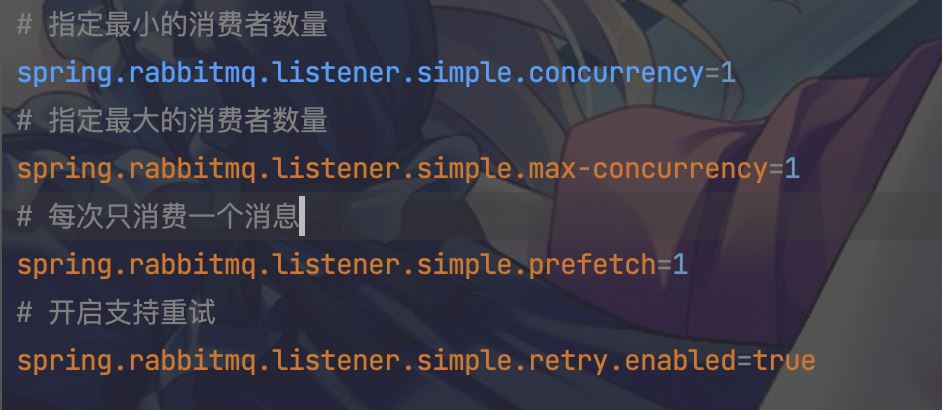
4. 发布订阅模式(Publish/Subscibe模式)
订阅模式–多个消费者监听不同的队列,但队列都绑定同一个交换机
1 编写订阅配置类
package com.gmtgo.demo.fanout;import org.springframework.amqp.core.Binding;import org.springframework.amqp.core.BindingBuilder;import org.springframework.amqp.core.FanoutExchange;import org.springframework.amqp.core.Queue;import org.springframework.context.annotation.Bean;import org.springframework.context.annotation.Configuration;@Configurationpublic class FanoutQueueConfig { private final String fanout1 = "fanout_queue_1"; private final String fanout2 = "fanout_queue_2"; private final String fanoutExchange = "fanoutExchange"; @Bean public Queue fanoutQueue1() { return new Queue(fanout1); } @Bean public Queue fanoutQueue2() { return new Queue(fanout2); } @Bean public FanoutExchange exchange() { return new FanoutExchange(fanoutExchange); } @Bean public Binding bindingFanoutQueue1(Queue fanoutQueue1, FanoutExchange exchange) { return BindingBuilder.bind(fanoutQueue1).to(exchange); } @Bean public Binding bindingFanoutQueue2(Queue fanoutQueue2, FanoutExchange exchange) { return BindingBuilder.bind(fanoutQueue2).to(exchange); }}2 编写订阅生产者
package com.gmtgo.demo.fanout;import lombok.extern.slf4j.Slf4j;import org.springframework.amqp.rabbit.core.RabbitTemplate;import org.springframework.beans.factory.annotation.Autowired;import org.springframework.stereotype.Component;@Slf4j@Componentpublic class FanoutProducer { @Autowired private RabbitTemplate rabbitTemplate; public void sendMessage() { for (int i = 0; i < 5; i++) { String message = "订阅模式消息" + i; log.info("我是生产信息:{}", message); rabbitTemplate.convertAndSend("fanoutExchange", "", message); } }}3 编写订阅消费者1
package com.gmtgo.demo.fanout;import com.rabbitmq.client.Channel;import lombok.extern.slf4j.Slf4j;import org.springframework.amqp.core.Message;import org.springframework.amqp.rabbit.annotation.RabbitListener;import org.springframework.stereotype.Component;import java.io.IOException;@Slf4j@Componentpublic class FanoutConsumers1 { @RabbitListener(queues = "fanout_queue_1") public void readMessage(Message message, Channel channel) throws IOException { channel.basicAck(message.getMessageProperties().getDeliveryTag(), false); log.info("我是消费信息1:{}", new String(message.getBody())); }}4 编写订阅消费者2
package com.gmtgo.demo.fanout;import com.rabbitmq.client.Channel;import lombok.extern.slf4j.Slf4j;import org.springframework.amqp.core.Message;import org.springframework.amqp.rabbit.annotation.RabbitListener;import org.springframework.stereotype.Component;import java.io.IOException;@Slf4j@Componentpublic class FanoutConsumers2 { @RabbitListener(queues = "fanout_queue_2") public void readMessage(Message message, Channel channel) throws IOException { channel.basicAck(message.getMessageProperties().getDeliveryTag(), false); log.info("我是消费信息2:{}", new String(message.getBody())); }}5 编写测试方法
package com.gmtgo.demo.fanout;import org.springframework.beans.factory.annotation.Autowired;import org.springframework.web.bind.annotation.RequestMapping;import org.springframework.web.bind.annotation.RestController;@RestController@RequestMapping(value = "rabbitMq")public class FanoutRabbitMqController { @Autowired private FanoutProducer fanoutProducer; @RequestMapping(value = "fanoutQueueTest") public String fanoutQueueTest() { fanoutProducer.sendMessage(); return "success"; }}6 测试启动项目访问 fanoutQueueTest
访问地址http://127.0.0.1:8801/rabbitMq/fanoutQueueTest
结果:

控制台打印 ,发现两个绑定了不同队列的消费者都接受到了同一条消息查看RabbitMq 服务器:



5. 路由模式(Route模式 Direct定向)
1 编写路由配置类
package com.gmtgo.demo.direct;import org.springframework.amqp.core.Binding;import org.springframework.amqp.core.BindingBuilder;import org.springframework.amqp.core.DirectExchange;import org.springframework.amqp.core.Queue;import org.springframework.context.annotation.Bean;import org.springframework.context.annotation.Configuration;@Configurationpublic class DirectQueueConfig { private final String direct1 = "direct_queue_1"; private final String direct2 = "direct_queue_2"; private final String directExchange = "directExchange"; @Bean public Queue directQueue1() { return new Queue(direct1); } @Bean public Queue directQueue2() { return new Queue(direct2); } @Bean public DirectExchange directExchange() { return new DirectExchange(directExchange); } @Bean Binding bindingDirectExchange1(Queue directQueue1, DirectExchange exchange) { return BindingBuilder.bind(directQueue1).to(exchange).with("update"); } @Bean Binding bindingDirectExchange2(Queue directQueue2, DirectExchange exchange) { return BindingBuilder.bind(directQueue2).to(exchange).with("add"); }}2 编写生产者
package com.gmtgo.demo.direct;import lombok.extern.slf4j.Slf4j;import org.springframework.amqp.rabbit.core.RabbitTemplate;import org.springframework.beans.factory.annotation.Autowired;import org.springframework.stereotype.Component;@Slf4j@Componentpublic class DirectProducer { @Autowired private RabbitTemplate rabbitTemplate; public void sendMessageA() { for (int i = 0; i < 5; i++) { String message = "路由模式--routingKey=update消息" + i; log.info("我是生产信息:{}", message); rabbitTemplate.convertAndSend("directExchange", "update", message); } } public void sendMessageB() { for (int i = 0; i < 5; i++) { String message = "路由模式--routingKey=add消息" + i; log.info("我是生产信息:{}", message); rabbitTemplate.convertAndSend("directExchange", "add", message); } }}3 编写消费者1
package com.gmtgo.demo.direct;import com.rabbitmq.client.Channel;import lombok.extern.slf4j.Slf4j;import org.springframework.amqp.core.Message;import org.springframework.amqp.rabbit.annotation.RabbitListener;import org.springframework.stereotype.Component;import java.io.IOException;@Slf4j@Componentpublic class DirectConsumers1 { @RabbitListener(queues = "direct_queue_1") public void readMessage(Message message, Channel channel) throws IOException { channel.basicAck(message.getMessageProperties().getDeliveryTag(), false); log.info("我是消费信息1:{}", new String(message.getBody())); }}4 编写消费者2
package com.gmtgo.demo.direct;import com.rabbitmq.client.Channel;import lombok.extern.slf4j.Slf4j;import org.springframework.amqp.core.Message;import org.springframework.amqp.rabbit.annotation.RabbitListener;import org.springframework.stereotype.Component;import java.io.IOException;@Slf4j@Componentpublic class DirectConsumers2 { @RabbitListener(queues = "direct_queue_2") public void readMessage(Message message, Channel channel) throws IOException { channel.basicAck(message.getMessageProperties().getDeliveryTag(), false); log.info("我是消费信息2:{}", new String(message.getBody())); }}5 编写访问类
package com.gmtgo.demo.direct;import org.springframework.beans.factory.annotation.Autowired;import org.springframework.web.bind.annotation.RequestMapping;import org.springframework.web.bind.annotation.RestController;@RestController@RequestMapping(value = "rabbitMq")public class DirectRabbitMqController { @Autowired private DirectProducer directProducer; @RequestMapping(value = "directQueueTest1") public String directQueueTest1() { directProducer.sendMessageA(); return "success"; } @RequestMapping(value = "directQueueTest2") public String directQueueTest2() { directProducer.sendMessageB(); return "success"; }}6 测试启动项目访问directQueueTest1 , directQueueTest2
访问地址http://127.0.0.1:8801/rabbitMq/directQueueTest1
访问地址http://127.0.0.1:8801/rabbitMq/directQueueTest2
结果:directQueueTest1:

directQueueTest2:

6. 主题模式(Topics模式 Tpoic通配符)
1 编写路由配置类
package com.gmtgo.demo.topic;import org.springframework.amqp.core.*;import org.springframework.context.annotation.Bean;import org.springframework.context.annotation.Configuration;@Configurationpublic class TopicQueueConfig { private final String topic1 = "topic_queue_1"; private final String topic2 = "topic_queue_2"; private final String topicExchange = "topicExchange"; @Bean public Queue topicQueue1() { return new Queue(topic1); } @Bean public Queue topicQueue2() { return new Queue(topic2); } @Bean public TopicExchange topicExchange() { return new TopicExchange(topicExchange); } @Bean Binding bindingTopicExchange1(Queue topicQueue1, TopicExchange exchange) { return BindingBuilder.bind(topicQueue1).to(exchange).with("topic.keyA"); } @Bean Binding bindingTopicExchange2(Queue topicQueue2, TopicExchange exchange) { return BindingBuilder.bind(topicQueue2).to(exchange).with("topic.#"); }}2 编写生产者
package com.gmtgo.demo.topic;import lombok.extern.slf4j.Slf4j;import org.springframework.amqp.rabbit.core.RabbitTemplate;import org.springframework.beans.factory.annotation.Autowired;import org.springframework.stereotype.Component;@Slf4j@Componentpublic class TopicProducer { @Autowired private RabbitTemplate rabbitTemplate; public void sendMessageA() { for (int i = 0; i < 5; i++) { String message = "通配符模式--routingKey=topic.keyA消息" + i; log.info("我是生产信息:{}", message); rabbitTemplate.convertAndSend("topicExchange", "topic.keyA", message); } } public void sendMessageB() { for (int i = 0; i < 5; i++) { String message = "通配符模式--routingKey=topic.#消息" + i; log.info("我是生产信息:{}", message); rabbitTemplate.convertAndSend("topicExchange", "topic.keyD.keyE", message); } }}3 编写消费者1
package com.gmtgo.demo.topic;import com.rabbitmq.client.Channel;import lombok.extern.slf4j.Slf4j;import org.springframework.amqp.core.Message;import org.springframework.amqp.rabbit.annotation.RabbitListener;import org.springframework.stereotype.Component;import java.io.IOException;@Slf4j@Componentpublic class TopicConsumers1 { @RabbitListener(queues = "topic_queue_1") public void readMessage(Message message, Channel channel) throws IOException { channel.basicAck(message.getMessageProperties().getDeliveryTag(), false); log.info("我是消费信息1:{}",new String(message.getBody())); }}4 编写消费者2
package com.gmtgo.demo.topic;import com.rabbitmq.client.Channel;import lombok.extern.slf4j.Slf4j;import org.springframework.amqp.core.Message;import org.springframework.amqp.rabbit.annotation.RabbitListener;import org.springframework.stereotype.Component;import java.io.IOException;@Slf4j@Componentpublic class TopicConsumers2 { @RabbitListener(queues = "topic_queue_2") public void readMessage(Message message, Channel channel) throws IOException { channel.basicAck(message.getMessageProperties().getDeliveryTag(), false); log.info("我是消费信息2:{}",new String(message.getBody())); }}5 编写访问类
package com.gmtgo.demo.topic;import org.springframework.beans.factory.annotation.Autowired;import org.springframework.web.bind.annotation.RequestMapping;import org.springframework.web.bind.annotation.RestController;@RestController@RequestMapping(value = "rabbitMq")public class TopicRabbitMqController { @Autowired private TopicProducer topicProducer; @RequestMapping(value = "topicQueueTest1") public String topicQueueTest1() { topicProducer.sendMessageA(); return "success"; } @RequestMapping(value = "topicQueueTest2") public String topicQueueTest2() { topicProducer.sendMessageB(); return "success"; }}6 测试启动项目访问topicQueueTest1 , topicQueueTest2
访问地址http://127.0.0.1:8801/rabbitMq/topicQueueTest1
访问地址http://127.0.0.1:8801/rabbitMq/topicQueueTest2
结果:
topicQueueTest1,两个消费者都能消费
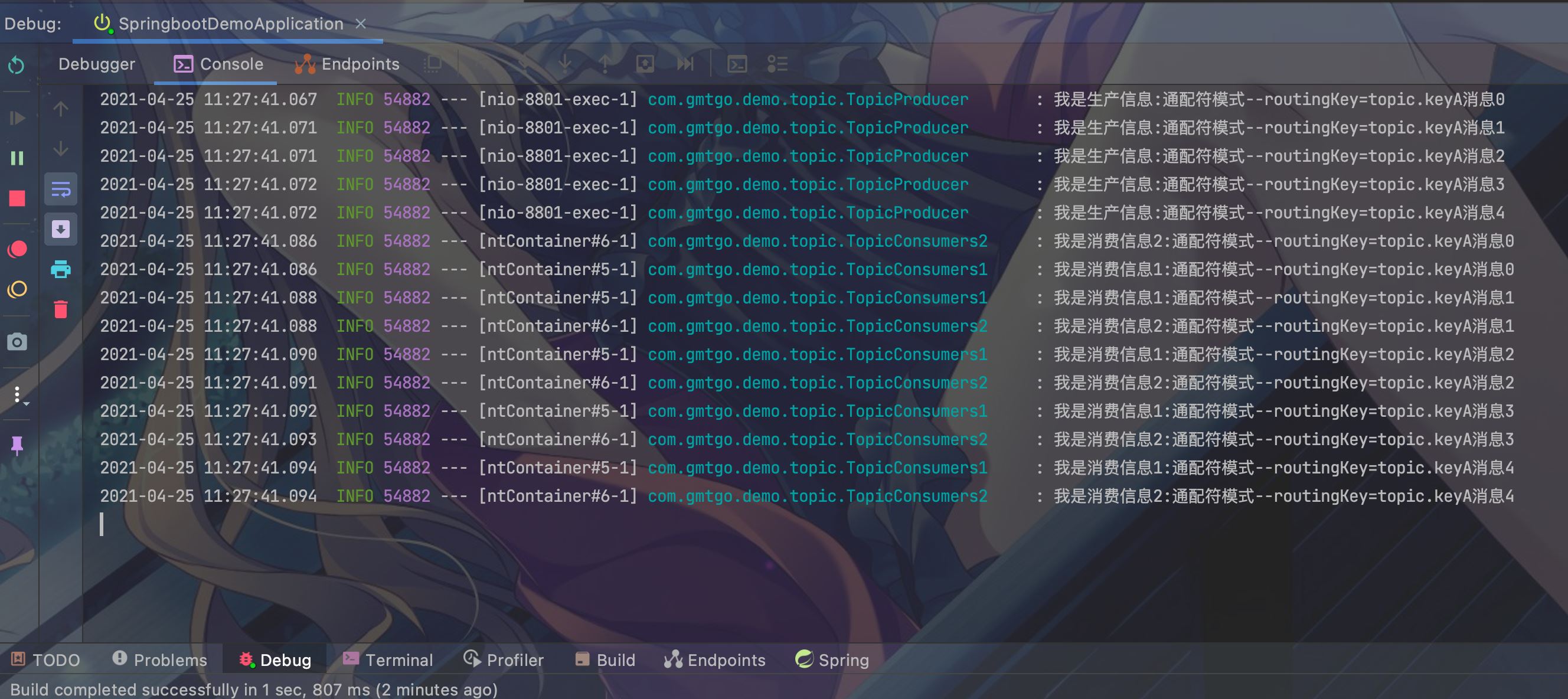
topicQueueTest2,只有消费者2 可以消费

至此,五种队列的实现已结束!
7. 实现生产者消息确认
1 配置文件
######################### RabbitMQ配置 ######################### RabbitMQ主机spring.rabbitmq.host=127.0.0.1# RabbitMQ虚拟主机spring.rabbitmq.virtual-host=demo# RabbitMQ服务端口spring.rabbitmq.port=5672# RabbitMQ服务用户名spring.rabbitmq.username=admin# RabbitMQ服务密码spring.rabbitmq.password=admin# RabbitMQ服务发布确认属性配置## NONE值是禁用发布确认模式,是默认值## CORRELATED值是发布消息成功到交换器后会触发回调方法## SIMPLE值经测试有两种效果,其一效果和CORRELATED值一样会触发回调方法,其二在发布消息成功后使用rabbitTemplate调用waitForConfirms或waitForConfirmsOrDie方法等待broker节点返回发送结果,根据返回结果来判定下一步的逻辑,要注意的点是waitForConfirmsOrDie方法如果返回false则会关闭channel,则接下来无法发送消息到broker;spring.rabbitmq.publisher-confirm-type=simple# 连接超时时间spring.rabbitmq.connection-timeout=20000# RabbitMQ服务开启消息发送确认spring.rabbitmq.publisher-returns=true######################### simple模式配置 ######################### RabbitMQ服务 消息接收确认模式## NONE:不确认## AUTO:自动确认## MANUAL:手动确认spring.rabbitmq.listener.simple.acknowledge-mode=manual# 指定最小的消费者数量spring.rabbitmq.listener.simple.concurrency=1# 指定最大的消费者数量spring.rabbitmq.listener.simple.max-concurrency=1# 每次只消费一个消息spring.rabbitmq.listener.simple.prefetch=1# 开启支持重试spring.rabbitmq.listener.simple.retry.enabled=true# 启用强制信息,默认为falsespring.rabbitmq.template.mandatory=true2 编写消息发送确认类 RabbitConfirmCallback
package com.gmtgo.demo.config;import lombok.extern.slf4j.Slf4j;import org.springframework.amqp.rabbit.connection.CorrelationData;import org.springframework.amqp.rabbit.core.RabbitTemplate;@Slf4jpublic class RabbitConfirmCallback implements RabbitTemplate.ConfirmCallback { @Override public void confirm(CorrelationData correlationData, boolean ack, String cause) { log.info("=======ConfirmCallback========="); log.info("correlationData {} " , correlationData); log.info("ack = {}" , ack); log.info("cause = {}" , cause); log.info("=======ConfirmCallback========="); }}3 编写消息发送交换机返回机制RabbitConfirmReturnCallBack
package com.gmtgo.demo.config;import lombok.extern.slf4j.Slf4j;import org.springframework.amqp.core.Message;import org.springframework.amqp.rabbit.core.RabbitTemplate;@Slf4jpublic class RabbitConfirmReturnCallBack implements RabbitTemplate.ReturnCallback { @Override public void returnedMessage(Message message, int replyCode, String replyText, String exchange, String routingKey) { log.info("--------------ReturnCallback----------------"); log.info("message = " + message); log.info("replyCode = {}", replyCode); log.info("replyText = {}", replyText); log.info("exchange = {}", exchange); log.info("routingKey = {}", routingKey); log.info("--------------ReturnCallback----------------"); }}4 RabbitMQ配置
在我们的rabbit队列配置类里设置RabbitTemplate
举例:
package com.gmtgo.demo.topic;import com.gmtgo.demo.config.RabbitConfirmCallback;import com.gmtgo.demo.config.RabbitConfirmReturnCallBack;import org.springframework.amqp.core.Binding;import org.springframework.amqp.core.BindingBuilder;import org.springframework.amqp.core.Queue;import org.springframework.amqp.core.TopicExchange;import org.springframework.amqp.rabbit.core.RabbitTemplate;import org.springframework.beans.factory.annotation.Autowired;import org.springframework.context.annotation.Bean;import org.springframework.context.annotation.Configuration;import javax.annotation.PostConstruct;@Configurationpublic class TopicQueueConfig { @Autowired private RabbitTemplate rabbitTemplate; @PostConstruct public void initRabbitTemplate() { // 设置生产者消息确认 rabbitTemplate.setConfirmCallback(new RabbitConfirmCallback()); rabbitTemplate.setReturnCallback(new RabbitConfirmReturnCallBack()); } private final String topic1 = "topic_queue_1"; private final String topic2 = "topic_queue_2"; private final String topicExchange = "topicExchange"; @Bean public Queue topicQueue1() { return new Queue(topic1); } @Bean public Queue topicQueue2() { return new Queue(topic2); } @Bean public TopicExchange topicExchange() { return new TopicExchange(topicExchange); } @Bean Binding bindingTopicExchange1(Queue topicQueue1, TopicExchange exchange) { return BindingBuilder.bind(topicQueue1).to(exchange).with("topic.keyA"); } @Bean Binding bindingTopicExchange2(Queue topicQueue2, TopicExchange exchange) { return BindingBuilder.bind(topicQueue2).to(exchange).with("topic.#"); }}启动项目发送消息,消息被正常消费,confim回调返回ack=true如果我们将exchange修改,发送到一个不存在的exchange中,会怎么样呢?
会发现confirm回调为false,打印出结果为不存在topicExchange1111的交换机

如果我们在消费端处理逻辑时出错会怎么样呢?修改消费端代码我们在消费时让它报错

confirm回调为true,但是在rabbitmq的web界面会发现存在5条没有消费的消息

如果我们把
channel.basicNack(message.getMessageProperties().getDeliveryTag(),false,false);中最后一个参数改为false呢,会发现在web管理界面没有未被消费的消息,说明这条消息已经被摒弃。
实际开发中,到底是打回到队列呢还是摒弃,要看自己的需求,但是打回队列应该有次数限制,不然会陷入死循环。
继续测试,将routingKey修改为一个没有的key,
5 结论
如果消息没有到exchange,则confirm回调,ack=false
如果消息到达exchange,则confirm回调,ack=true
exchange到queue成功,则不回调return
exchange到queue失败,则回调return
感谢你能够认真阅读完这篇文章,希望小编分享的“rabbitmq五种模式的示例分析”这篇文章对大家有帮助,同时也希望大家多多支持编程网,关注编程网行业资讯频道,更多相关知识等着你来学习!




